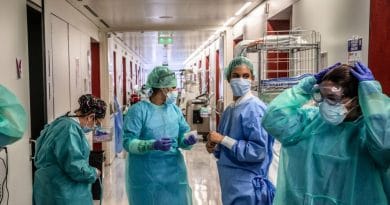No new cases of COVID-19, as vaccinations underway in Nunatsiavut
Provincial officials are reporting no new cases of COVID-19 in Newfoundland and Labrador on Monday, as the Moderna vaccine starts to roll out in Labrador’s five Inuit communities..
Monday’s briefing is the first live update since Wednesday. There was one new travel-related case announced over the weekend, making for five active cases in the province.
One person is in hospital.
Earlier on Monday, doses of the Moderna vaccine were on a plane headed for Makkovik, where the first of Nunatsiavut’s inoculations got underway.
Elder Willie Ford was the first person in Makkovik to receive the vaccine, at 9:18 a.m. AT.
“This is amazing. It’s remarkable,” said Gerald Asivak, the Nunatsiavut government’s minister of health and social development.
“I’m excited, happy, overjoyed, relieved. We’ve been waiting for this day for a long time.”
COVID 19 vaccination have begun in <a href=”https://twitter.com/hashtag/Nunatsiavut?src=hash&ref_src=twsrc%5Etfw”>#Nunatsiavut</a>. <a href=”https://twitter.com/hashtag/Makkovik?src=hash&ref_src=twsrc%5Etfw”>#Makkovik</a> Myself, Ordinary Member John Andersen, and elder William Ford in the pics. Historic day given the past history in <a href=”https://twitter.com/hashtag/Labrador?src=hash&ref_src=twsrc%5Etfw”>#Labrador</a> Spanish Flu. Okak. Zero COVID19 cases to date. Amazing day. <a href=”https://t.co/W8vCbE7sxV”>pic.twitter.com/W8vCbE7sxV</a>
—@BarryAndersen3
As of Sunday, Newfoundland and Labrador had received 8,250 doses of vaccine from both Moderna and Pfizer-BioNTech.
It has administered 3,760 doses so far, according to data provided by the Department of Health. By the end of February, more than 25,000 additional vaccine doses are expected.

Premier Andrew Furey confirmed Monday that vaccinations are also starting Monday in long-term care facilities. Health-case workers continue to receive shots at hubs in the Eastern, Western and Central Health regions.
Timeline under fire
Opposition MHA David Brazil criticized the province Monday, saying officials were dragging their heels on getting vaccines into the arms of residents.
“We know who our health-care workers are. We know who our first responders are. There’s no reason why that process couldn’t be in place to ensure that they get it or to ensure that more long-term care patients are getting their vaccine as soon as possible,” he said.
Newfoundland and Labrador has the second-lowest vaccination rate in the country.
Brazil told CBC he believes the province deserves a larger proportion of vaccines, given its demographics and strict travel restrictions that have kept the virus at bay.
Furey and Health Minister John Haggie have defended their distribution plan, pointing to logistical hurdles for setting up an inoculation program along the north coast, such as training and language translation issues. Manuals for the vaccine were not immediately available in Inuktitut, Haggie said last week.
Furey confirmed that province is also expecting more vaccines than it was originally told it would by the end of January: 15,000 rather than 13,000.
Watch the provincial government’s briefing stream:
Furey said Monday that Brazil is “playing politics with health.”
“This isn’t always about speed,” said the premier. “It’s about getting it right.”
The province has also held onto some of its vaccine stores for second doses, said Chief Medical Officer of Health Dr. Janice Fitzgerald.
“We want to make sure we have enough here to be able to give that second dose on time,” Fitzgerald said, referring to the window of time recommended by manufacturers for a booster shot.
“These schedules can have bumps in the road, and we want to make sure we’re not left not being able to give that second dose when we should.”
The Nunatsiavut government, he added, is in charge of distribution along the north coast.
Nunatsivut handling logistics
The province has identified remote, isolated Indigenous communities as one of the priority groups for vaccinations. Nunatsiavut is distributing the Moderna vaccine — which is more stable and has fewer travel restrictions — in the communities of Nain, Hopedale, Postville, Makkovik and Rigolet.
Asivak said health-care workers in Nunatsiavut have been speaking with residents about the vaccine so they know what to expect, and priority is being given to health-care workers and elders. But, he added, there are enough doses for all residents over the age of 18.
“There’s already been appointments made prior to today. There’s been health workers in each community visiting seniors and explaining what Moderna is and the vaccine and the process,” he told CBC’s Labrador Morning.
“It’s very similar to a flu shot. There’ll be seven nurses in each station. One will be specified to do screening to ensure people have informed consent of what the vaccine is about, and then they’ll stay for 15 minutes after the vaccine shot just to ensure that everything is OK, and they’ll be given information about any other symptoms and call 811 or check with a local clinic.”

The vaccination is voluntary, Asivak said, but he hopes people will get the vaccine to ensure their community is safe from COVID-19.
“We strongly recommend that you get vaccinated for your own safety, for your family, for your community. It is important. We’ve been waiting so long for this, I can’t stress it enough,” he said.
“A lot of the COVID-19 transmissions have been travel-related so this is one way to protect yourself — by getting inoculated.”
Public health measures still apply to the immune
Fitzgerald said anyone who receives a vaccine must still abide by public health rules, including wearing a mask indoors in public places and self-isolating after travel outside the province.
She also addressed what she called “a little bit of complacency setting in” about mask usage and said she’s heard concerns from the public about slipping vigilance.
“Non-medical masks do not replace physical distancing,” she said Monday. “When worn properly they add a layer of protection when physical distancing is not possible.”
She said a mask is not effective when worn under the nose. Masks with valves are not recommended, she said, and neither are face shields, when worn without a mask. Fitzgerald said droplets can escape through any openings in a face covering.

